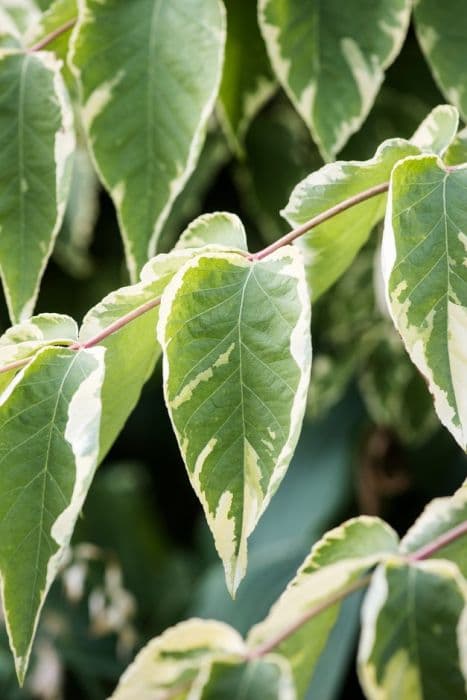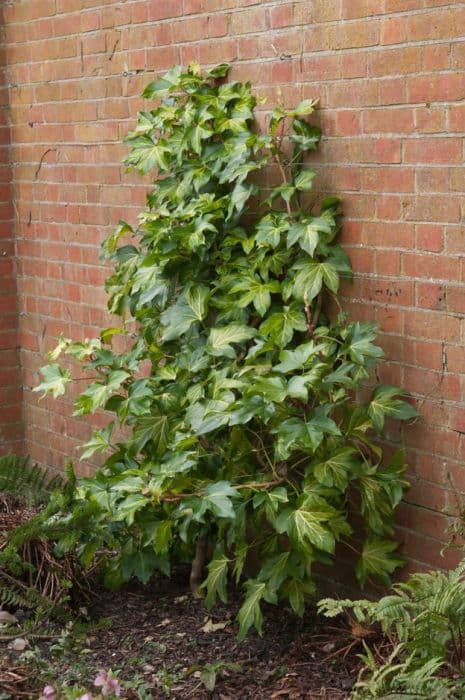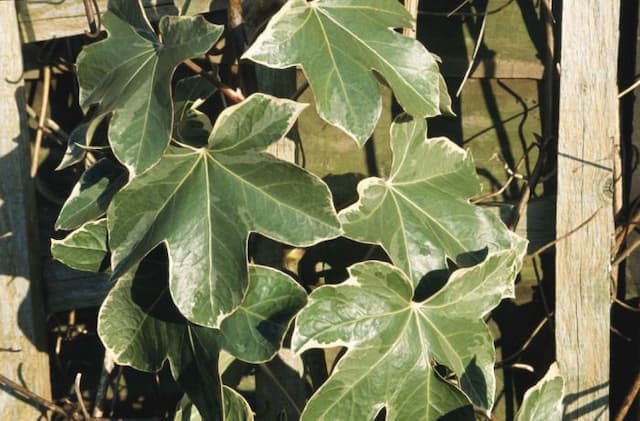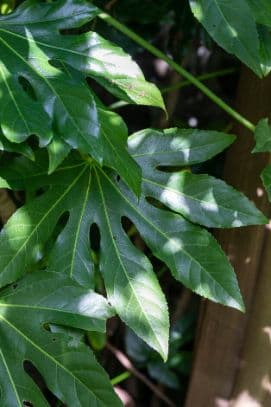English Ivy Hedera helix 'Midas Touch' (v)
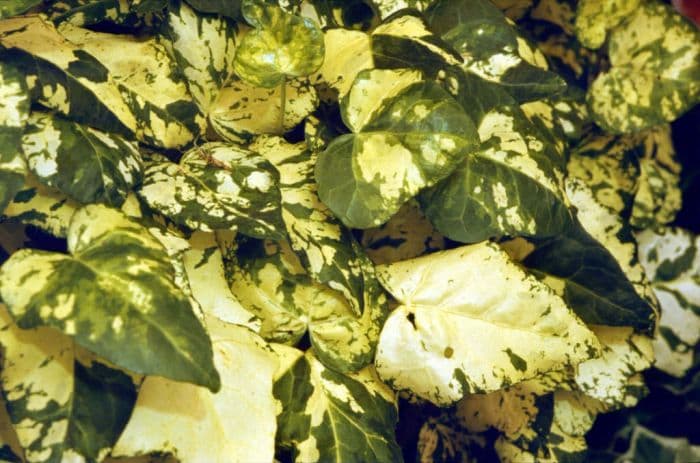
ABOUT
The English ivy known as 'Midas Touch' is a visually striking variety that stands out for its unique foliage. The leaves of this ivy are heart-shaped with a glossy surface, providing a lush and vibrant look. Each leaf, while retaining the classic deep green hue associated with English ivy, is variegated with splashes of gold or yellow, giving the appearance that the plant has been touched by gold, hence the name 'Midas Touch'. The leaves are arranged alternately along the stems, which trail or climb depending on the support they find. The veins on the leaves are prominent and create a beautiful contrast with the variegation. This ivy's aesthetic makes it a popular choice for adding a touch of elegance to gardens, with its leaves providing a dual-tone color palette that can brighten up shaded areas.
About this plant
 Names
NamesFamily
Araliaceae.
Synonyms
English Ivy, Common Ivy, European Ivy.
Common names
Hedera helix 'Midas Touch'
 Toxicity
ToxicityTo humans
The common name of Hedera helix 'Midas Touch' is English ivy. English ivy is considered to be toxic if ingested by humans. The symptoms of poisoning may include abdominal pain, vomiting, and diarrhea. In some cases, it can also cause excessive salivation, inflammation of the skin (dermatitis), and difficulty in swallowing if the plant parts come into contact with the mucous membranes inside the mouth. The saponins and polyacetylene compounds present in the plant are known to be the toxic elements.
To pets
English ivy is also toxic to pets, including cats and dogs. Ingesting any part of the plant can cause symptoms such as abdominal pain, vomiting, hypersalivation, and diarrhea. In severe cases, pets may experience difficulty breathing, weakness, muscle spasms, or even coma. The toxicity is primarily due to the saponins found in the plant, which can cause cell membrane disruptions and other adverse effects when ingested. It is important for pet owners to keep this plant out of reach of their animals.
 Characteristics
CharacteristicsLife cycle
Perennials
Foliage type
Evergreen
Color of leaves
Variegated
Height
50-100 feet (15-30 meters)
Spread
6-50 feet (2-15 meters)
Plant type
Climber
Hardiness zones
5-9
Native area
Europe
Benefits
 General Benefits
General Benefits- Visual Appeal: With its variegated golden-yellow and green leaves, it adds a vibrant splash of color to any setting.
- Versatile Growth: Can be grown as a climber or groundcover, suitable for walls, fences, and garden beds.
- Low Maintenance: Once established, it requires minimal care, making it a good choice for busy gardeners.
- Adaptability: Tolerates a range of light conditions from full sun to shade.
- Drought Tolerance: Capable of withstanding periods of low water availability once fully rooted.
- Cold Hardy: Can survive in cooler temperatures, making it suitable for a variety of climates.
- Wildlife Support: Provides habitats for birds and insects, contributing to biodiversity.
- Evergreen: Maintains its foliage year-round, offering continuous visual interest.
- Soil Erosion Control: Its dense growth can help prevent soil erosion, especially when used as groundcover.
- Easy Propagation: Easily propagated by stem cuttings, allowing for rapid expansion of the plant if desired.
 Medical Properties
Medical Properties- Expectorant: English ivy has been traditionally used to help relieve cough and congestion.
- Anti-inflammatory: It may contain properties that reduce inflammation, potentially beneficial in the treatment of certain inflammatory conditions.
- Antispasmodic: English ivy extracts have been regarded for their potential to reduce muscle spasms.
- Antimicrobial: Some research suggests that English ivy may possess antimicrobial properties, which could help in fighting certain infections.
- Mucolytic: The saponins present in English ivy can help break down mucus, aiding in the relief of cold symptoms.
 Air-purifying Qualities
Air-purifying QualitiesThis plant is not specifically known for air purifying qualities.
 Other Uses
Other Uses- Creating a textured surface on model landscapes: The small leaves and flexible stems of English ivy can be used to add realistic vegetation to miniature models or dioramas.
- Natural dye source: English ivy can be used to produce a range of dyes for fabrics, with various parts of the plant yielding different shades.
- Privacy screens in aquaria: When cultivated underwater, English ivy can provide shelter and privacy for fish and other aquatic creatures.
- Decoration for cakes: With proper cleaning, the leaves can be used to add a natural green touch to cake decorations or as a base for displaying the cake.
- As a living sculpture: Skilled gardeners can train English ivy to grow around frames, forming interesting shapes and living sculptures.
- Homemade wreaths and garlands: The vines are flexible and durable, making them an excellent base for creating festive decorations.
- Tool for teaching biology: English ivy is a good subject for studying plant growth, photosynthesis, and climbing plant behavior in educational settings.
- Erosion control: The plant's dense growth can be used to stabilize soil on slopes and prevent erosion in certain landscapes.
- Filler for floral arrangements: English ivy can add greenery and volume to bouquets and other floral displays without overpowering the featured flowers.
- Photography prop: The lush foliage and climbing nature of English ivy can be used to create enchanting and mystical backgrounds for photo shoots.
Interesting Facts
 Feng Shui
Feng ShuiEnglish Ivy is not used in Feng Shui practice.
 Zodiac Sign Compitability
Zodiac Sign CompitabilityEnglish Ivy is not used in astrology practice.
 Plant Symbolism
Plant Symbolism- Connection and Friendship: English Ivy, as a plant that naturally climbs and supports itself on other structures, symbolizes strong bonds and connections, much like the intertwined growth pattern that signifies the interdependence in relationships.
- Eternity and Fidelity: Due to its perennial nature and evergreen leaves, English Ivy stands for eternal life and unwavering fidelity, reflecting an enduring and steadfast attachment.
- Protection and Healing: Historically, ivy has been thought to have protective qualities, often used in folk medicine and believed to safeguard against negative energy and spirits.
- Survival and Resilience: English Ivy's ability to grow in challenging conditions represents resilience and the power to survive and even thrive in tough situations.
- Growth and Renewal: The ever-expanding nature of ivy, with its ability to regenerate and grow in new directions, symbolizes personal growth, renewal, and the pursuit of endeavors.
 Water
WaterEnglish Ivy 'Midas Touch' prefers to be kept in evenly moist soil, so it's important to water it thoroughly when the top inch of soil feels dry to the touch. Depending on the environment, this might mean watering once every week or two. It’s generally recommended to water with about one gallon of water, ensuring excess water drains away to prevent root rot. During the growing season, they may need more frequent watering, but always check the soil moisture before adding water.
 Light
LightEnglish Ivy 'Midas Touch' thrives in bright, indirect light but will also tolerate lower light conditions. The ideal spot for this plant is near a window that receives filtered sunlight or has a sheer curtain to diffuse direct rays. Avoid placing it in full sun to prevent leaf scorch, and rotate the plant periodically to ensure even growth.
 Temperature
TemperatureEnglish Ivy 'Midas Touch' does best in temperatures between 50 to 70 degrees Fahrenheit but can tolerate a range from the mid-30s to mid-80s. They should be protected from extreme cold and hot temperatures, as this can stress the plant. Consistently maintaining the ideal temperature range will promote healthy growth and vitality.
 Pruning
PruningPruning English Ivy 'Midas Touch' helps maintain its shape, encourage bushier growth, and remove any unhealthy parts. It can be pruned any time of the year, but the best time is in the spring before the new growth starts. Prune as often as needed to keep the plant at the desired size and shape, using clean, sharp scissors or pruning shears.
 Cleaning
CleaningAs needed
 Soil
SoilEnglish Ivy 'Midas Touch' thrives in a well-draining, loamy soil mix with a pH of 5.5 to 6.5. A blend of two parts peat moss or coco coir, one part perlite, and one part compost is ideal for this variety.
 Repotting
RepottingEnglish Ivy 'Midas Touch' should be repotted every two to three years, or when the plant appears root-bound or the soil is exhausted.
 Humidity & Misting
Humidity & MistingEnglish Ivy 'Midas Touch' prefers a moderate humidity level, around 40-50%, which is typical for indoor environments.
 Suitable locations
Suitable locationsIndoor
Place in indirect light, keep soil moist, and provide moderate humidity.
Outdoor
Grow in shade or partial sun, shelter from harsh conditions.
Hardiness zone
5-11 USDA
 Life cycle
Life cycleHedera helix 'Midas Touch', commonly known as English Ivy, begins its life cycle as a seed, which germinates in fertile, moist soil typically in the spring. As a juvenile, the plant exhibits rapid vegetative growth with trailing stems and lobed leaves, and this stage can last for several years as it spreads over the ground or climbs surfaces using its aerial rootlets. When the plant reaches maturity, its growth habit changes and it develops sturdier, upright branches with unlobed, adult leaves. The mature English Ivy then produces clusters of small greenish-yellow flowers, usually in the late summer to fall, which are pollinated by insects. Following pollination, the flowers give way to small, blue-black berries that ripen in late winter to early spring and are consumed by birds, facilitating seed dispersal. After dispersal, the life cycle begins anew when the seeds germinate in a suitable location.
 Propogation
PropogationPropogation time
Spring to Summer
The most popular method of propagating English Ivy 'Midas Touch' is through stem cuttings. This process can be done at almost any time of the year, but the best results often come from propagating in the spring or early summer, as warmer temperatures and longer daylight hours support quicker growth. To propagate, a gardener should select a healthy piece of stem about 4 to 6 inches (approximately 10 to 15 cm) long and make a cut just below a leaf node, where the concentration of rooting hormones is high. The lower leaves should be removed, and the cut end can be dipped in rooting hormone powder to encourage root development, although this step is not strictly necessary as ivy generally roots well on its own. The stem is then planted in a pot filled with moist potting soil or a mixture of peat and perlite, and kept in indirect light. The soil should be kept consistently moist, but not waterlogged, to prevent rot. Roots typically develop within a few weeks, after which the new plants can be gradually acclimated to their permanent conditions.
